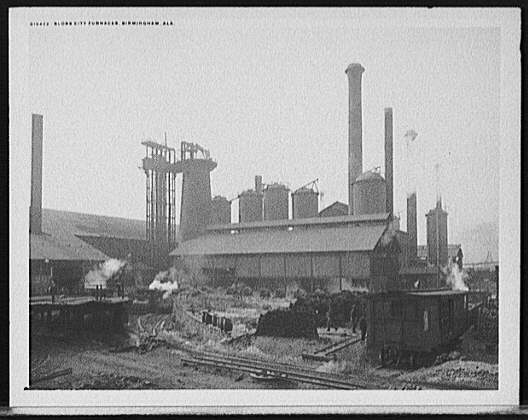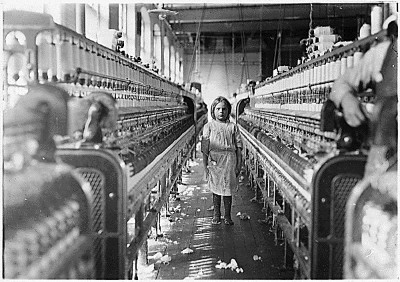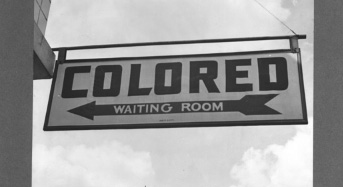History 263: The New South--Spring 2009
| Meets
MWF, 12:10-1:00 PM, Wilson 112 |
|
Updated January 8, 2009
Introduction
     The "New South"–romantic it ain't. The Old South
was columned mansions lorded over by hospitable, courtly gentlemen and ornamented
by belles, while gallant Confederate officers defended their Way of Life from
crude Yankee invaders (It was also a  rough,
violent land of whip-scarred slaves and impoverished white farmers–see History
262). The "New South," on the other hand, is whitebread–glass buildings, urban
sprawl, clogged expressways. If there's a history to the New South at all, it's
not terribly interesting–right? To the contrary--it is not until the death of
the Old South that southern history really got interesting. For the apparently
bland landscape of the modern South is haunted by dark ghosts. Sharecroppers still
work the Delta soil in the shadow of great machines; economic insecurity still
frequents the hollows of Appalachia and the mill towns of the Carolinas. Defeat
in war, and economic and political subordination to outside powers, generated
grievances among whites that have long survived modern prosperity and political
ascendancy. Above all, the New South has been a land of extremes–the extreme violence
of the lynch mob, the extreme inequality of plantations and company towns, the
extreme injustice of Jim Crow. All gone now, we think–and yet much closer to us
in time than we like to think, and within the living memories of many southerners,
including your instructor.
rough,
violent land of whip-scarred slaves and impoverished white farmers–see History
262). The "New South," on the other hand, is whitebread–glass buildings, urban
sprawl, clogged expressways. If there's a history to the New South at all, it's
not terribly interesting–right? To the contrary--it is not until the death of
the Old South that southern history really got interesting. For the apparently
bland landscape of the modern South is haunted by dark ghosts. Sharecroppers still
work the Delta soil in the shadow of great machines; economic insecurity still
frequents the hollows of Appalachia and the mill towns of the Carolinas. Defeat
in war, and economic and political subordination to outside powers, generated
grievances among whites that have long survived modern prosperity and political
ascendancy. Above all, the New South has been a land of extremes–the extreme violence
of the lynch mob, the extreme inequality of plantations and company towns, the
extreme injustice of Jim Crow. All gone now, we think–and yet much closer to us
in time than we like to think, and within the living memories of many southerners,
including your instructor.
     At
the same time, the end of slavery opened up southern society to the sort of contention
that had been silenced by the repression and paranoia of the slave regime. The
Reconstruction era gave former slaves new power not only to shape their own lives
but to shape their own government as well–power that a vicious white-supremacist
reaction could never completely destroy. Ordinary whites, finding themselves the
victims of "progress," sought economic change through the Populist movement and
other forms of action–or vented their frustrations on helpless blacks and a rear-guard
struggle against modernity. Other southerners–promoters of the first "New South,"
progressive-era social and educational reformers, post-World-War-II economic developers--grasped
at opportunities to remake the region in a modern image–a "modern image" that
until recently included the imposition of segregation and elite-white control
of politics. In the twentieth century, an expanding group of southern intellectuals
brought contention over the shape of southern society into the world of ideas.
And, finally, in your instructor's time, an indigenously southern civil rights
movement proved that the "southern way of life" did not have to be one thing only–that
the South was not a party line, or a frozen museum piece,  but
a living tradition that its people could draw upon to strive toward a better and
more just way of life.
but
a living tradition that its people could draw upon to strive toward a better and
more just way of life.
     Thus the story of the
New South is one of contention, indeed of revolution. The end of slavery, the
"unfinished revolution" of Reconstruction, the Populist "revolt," the economic
revolution of the New Deal and post-World-War-II years, the collapse of Jim Crow–these
were all times when southerners felt the earth move under their feet. If poverty,
racism, and the long-lasting sting of defeat and subordination still haunt the
South, its people have also shown, time after time, a creative capacity to pursue
and accommodate to change–a capacity drawing on distinctly southern traditions
of faith, democratic politics, and community solidarity. They have displayed even
more a capacity for artistic creativity, be it the high literary culture of the
Vanderbilt Agrarians or William Faulkner, or the folk arts of jazz, blues, and
the various streams of country music that have made "southern culture" so resonant
to the daily struggles of peoples around the world. If a truly "good" South remains
to be completed, southerners have the capacity to create it. If this course has
an "objective," it's to make that point.
 Course Outline and Assignments
|
Week of | Topics
and Assignments
| Readings |
| Jan. 7 |
The Aftermath of Defeat Jan. 9--The
South in 1865
| EGMT,
pp. 1-28 |
| Jan. 12 |
The Reconstruction Experiment
|
Roark,
pp. 1-108
|
| Jan. 19
|
The Collapse of Reconstruction
January 23--DISCUSSION--Essay
No. 1 Due*
| Roark,
pp. 111-209;
EGMT, pp. 29-57;
Thaddeus Stevens, Speech
at Lancaster, PA on September 6, 1865
|
| Jan.
26 |
Origins of the "New
South"--I
| EGMT,
pp. 58-88;
Carlton, pp. 1-128
|
| Feb. Â 2 |
Origins of the "New South"--II
February 6--DISCUSSION--Essay No. 2 Due*
|
EGMT, pp. 89-123, 187-214
|
| Feb. 9
| Populism
|
EGMT, pp. 124-154
|
| Feb.
16 |
February 16--DISCUSSION--Essay No. 3 Due*
February 18--MIDTERM EXAM
|
EGMT, pp. 155-186;
Wells, Southern Horrors
|
| Feb. 23 |
Disfranchisement
and the Rise of Jim Crow
|
EGMT, pp. 215-254
|
WEEK OF MARCH 2--SPRING BREAK
| Mar. 9
| Southern Progressivism
March 13--DISCUSSION--Essay
No. 4 Due*
|
EGMT,
pp. 255-286;
Carlton, pp. 129-272
|
| Mar.
16 | Progressivism and World War I
| Â |
| Mar. 23 |
The South in the 1920s
|
EGMT,
pp. 287-316
|
| Mar. 30 |
The New Deal and World War II
April 3--DISCUSSION--Essay No. 5 Due
|
EGMT,
pp. 317-348;
Carlton & Coclanis, Confronting Southern Poverty in the Great
Depression
|
| Apr.
 6 | The Postwar Revolution
|
Daniel, pp. 1-175
|
| Apr.
13 | The Civil Rights Era
|
EGMT,
pp. 349-385;
Daniel,
pp. 179-305
|
| Apr.
20 | The Post-Civil Rights
Era South
April 21--LAST CLASS--Essay
No. 6 Due*
| EGMT,
pp. 386-440 |
Monday, April 27, 9:00 AM--PRIMARY FINAL EXAMINATION
Thursday, April 30, Noon--ALTERNATE FINAL EXAMINATION
Nuts 'n' Bolts
There
will be one midterm examination in the course of the semester, which will
count 25 per cent of the final grade. The final examination will
count 30 per cent of the final grade. In addition, each student will write
three (3) short (3-4 pp.) papers in the course of the term, on topics to
be assigned in due course by the instructor; these will count 15 per cent each
of the final grade. Six opportunities to write will be provided in the course
of the term, keyed to the units between discussion sections. Each paper that you
choose to write will be due on the date of the appropriate discussion section,
marked above with an *. Except in clear medical or family emergencies, extensions
will be granted only if applied for at least one day in advance; past due papers
will lose one Vanderbilt grade point for each day (including weekends) overdue.
 Your attention is called to that portion of the VU Student Handbook
dealing with the Honor System. Note in particular that it is the student's responsibility
to understand the principles of intellectual honesty as they apply to this course
(to say nothing of how they apply to life in general). Feel free to consult the
instructor if issues of genuine moral ambiguity arise.
 Readings:
Paul D. Escott, David R. Goldfield, Sally G. McMillen,
and Helen Hayes Turner, eds., Major Problems in the History of the American
South, Volume II: The New South, Second Edition (Boston: Houghton Mifflin,
1999).
James L. Roark, Masters Without Slaves: Southern Planters in
the Civil War and Reconstruction (New York: W. W. Norton, 1977).
David L. Carlton, Mill and Town in South Carolina, 1880-1920 (Baton Rouge: Louisiana State University Press, 1982).
Jacqueline
Jones Royster, ed., Southern Horrors and Other Writings: The Anti-Lynching
Campaign of Ida B. Wells, 1892-1900 (Boston: Bedford/St. Martins, 1997).
David
L. Carlton and Peter A. Coclanis, eds., Confronting Southern Poverty in the
Great Depression (Boston: Bedford Books of St. Martin's Press, 1996).
Pete
Daniel, Lost Revolutions: The South in the 1950s (Chapel Hill: University
of North Carolina Press, 2000).
You have made hit No.  on this site. Thanks!
on this site. Thanks!
Questions? Comments? Contact david.l.carlton@vanderbilt.edu.
 rough,
violent land of whip-scarred slaves and impoverished white farmers–see History
262). The "New South," on the other hand, is whitebread–glass buildings, urban
sprawl, clogged expressways. If there's a history to the New South at all, it's
not terribly interesting–right? To the contrary--it is not until the death of
the Old South that southern history really got interesting. For the apparently
bland landscape of the modern South is haunted by dark ghosts. Sharecroppers still
work the Delta soil in the shadow of great machines; economic insecurity still
frequents the hollows of Appalachia and the mill towns of the Carolinas. Defeat
in war, and economic and political subordination to outside powers, generated
grievances among whites that have long survived modern prosperity and political
ascendancy. Above all, the New South has been a land of extremes–the extreme violence
of the lynch mob, the extreme inequality of plantations and company towns, the
extreme injustice of Jim Crow. All gone now, we think–and yet much closer to us
in time than we like to think, and within the living memories of many southerners,
including your instructor.
rough,
violent land of whip-scarred slaves and impoverished white farmers–see History
262). The "New South," on the other hand, is whitebread–glass buildings, urban
sprawl, clogged expressways. If there's a history to the New South at all, it's
not terribly interesting–right? To the contrary--it is not until the death of
the Old South that southern history really got interesting. For the apparently
bland landscape of the modern South is haunted by dark ghosts. Sharecroppers still
work the Delta soil in the shadow of great machines; economic insecurity still
frequents the hollows of Appalachia and the mill towns of the Carolinas. Defeat
in war, and economic and political subordination to outside powers, generated
grievances among whites that have long survived modern prosperity and political
ascendancy. Above all, the New South has been a land of extremes–the extreme violence
of the lynch mob, the extreme inequality of plantations and company towns, the
extreme injustice of Jim Crow. All gone now, we think–and yet much closer to us
in time than we like to think, and within the living memories of many southerners,
including your instructor.
 but
a living tradition that its people could draw upon to strive toward a better and
more just way of life.
but
a living tradition that its people could draw upon to strive toward a better and
more just way of life.